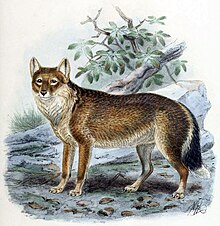Dusicyon
| Dusicyon[1] Temporal range: Late Pliocene to recent
| |
|---|---|

| |
| Scientific classification | |
| Domain: | Eukaryota |
| Kingdom: | Animalia |
| Phylum: | Chordata |
| Class: | Mammalia |
| Order: | Carnivora |
| Family: | Canidae |
| Subfamily: | Caninae |
| Tribe: | Canini |
| Genus: | †Dusicyon C. E. H. Smith, 1839[2] |
| Species | |
Dusicyon is an extinct genus of South American canids. The type species is Dusicyon australis, the Falkland Islands wolf. In 1914, Oldfield Thomas established this genus, in which he included the culpeo and other South American foxes. These other canids were removed to Lycalopex by Langguth in 1975.[3] Dusicyon avus, widely distributed in the late Pleistocene from Uruguay through Buenos Aires Province to southernmost Chile, is the closest known relative of the Falkland Islands wolf; the two lineages split only about 16,000 years ago.[4] It died out in the late Holocene, about 2980 years ago on the island of Tierra del Fuego and almost 1700 years in the continent.[5]
There is still much debate about the classification of "Dusicyon" cultridens. It has been suggested that this species be placed in the genera Canis or Lycalopex. This debate makes D. cultridens poorly researched.[citation needed]
References
- ^ Wozencraft, W. C. (2005). "Dusicyon". In Wilson, D. E.; Reeder, D. M. (eds.). Mammal Species of the World: A Taxonomic and Geographic Reference (3rd ed.). Johns Hopkins University Press. p. 579. ISBN 978-0-8018-8221-0. OCLC 62265494.
- ^ Jardine's Natur. Libr., 9: 248.
- ^ Wozencraft, W. C. (2005). "Lycalopex". In Wilson, D. E.; Reeder, D. M. (eds.). Mammal Species of the World: A Taxonomic and Geographic Reference (3rd ed.). Johns Hopkins University Press. pp. 579–581. ISBN 978-0-8018-8221-0. OCLC 62265494.
- ^ Cooper, A.; Mena, F.; Austin, J. J.; Soubrier, J.; Prevosti, F.; Prates, L.; Trejo, V. (2013). "The origin of the enigmatic Falkland Islands wolf". Nature Communications. 4: 1552. doi:10.1038/ncomms2570. PMID 23462995. Retrieved 2013-03-06.
- ^ Constraining the time of extinction of the South American fox Dusicyon avus (Carnivora, Canidae) during the late Holocene. Francisco Prevosti, Fernando Santiago, Luciano Prates, Mónica Salemme, and Fabiana Martin. Geophysical Research Abstracts Vol. 12, EGU2010-577-1, 2010. EGU General Assembly 2010 http://meetingorganizer.copernicus.org/EGU2010/EGU2010-577-1.pdf
External links
(Lycalopex mentioned as Dusicyon) THE DANGEROUS WILD ANIMALS ACT 1976 (MODIFICATION) (NO.2) ORDER 2007. http://www.legislation.gov.uk/uksi/2007/2465/schedule/made accessed 26 March 2014.
